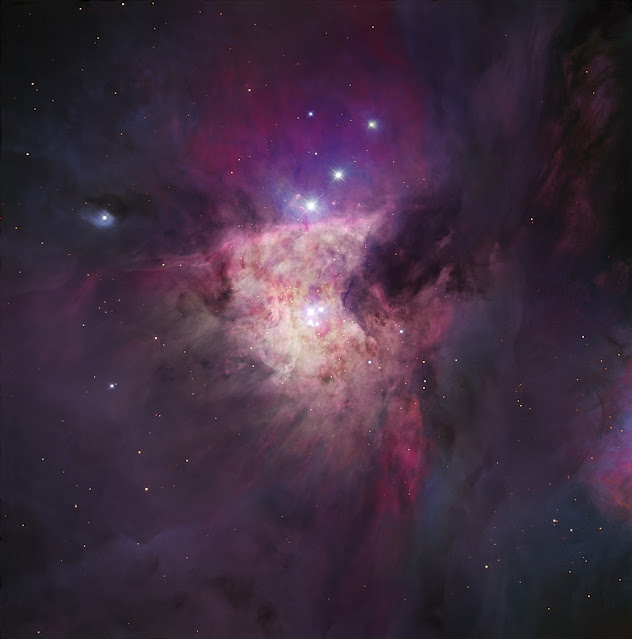Sun Glint on Titan's Lakes at Saturn | NASA Cassini Mission
On its final flyby of Saturn's largest moon in 2017, NASA's Cassini spacecraft gathered radar data revealing that the small liquid lakes in Titan's northern hemisphere are surprisingly deep, perched atop hills and filled with methane.
The findings, published April 15, 2019 in Nature Astronomy, were the first confirmation of just how deep some of Titan's lakes are (more than 300 feet, or 100 meters) and of their composition. They provide new information about the way liquid methane rains on, evaporates from and seeps into Titan—the only planetary body in our solar system other than Earth known to have stable liquid on its surface.
Scientists have known that Titan's hydrologic cycle works similarly to Earth's—with one major difference. Instead of water evaporating from seas, forming clouds and rain, Titan does it all with methane and ethane. We tend to think of these hydrocarbons as a gas on Earth, unless they are pressurized in a tank. However, Titan is so cold that they behave as liquids, like gasoline at room temperature on our planet.
Scientists have known that the much larger northern seas are filled with methane, but finding the smaller northern lakes filled mostly with methane was a surprise. Previously, Cassini data measured Ontario Lacus, the only major lake in Titan's southern hemisphere. There they found a roughly equal mix of methane and ethane. Ethane is slightly heavier than methane, with more carbon and hydrogen atoms in its makeup.
"Every time we make discoveries on Titan, Titan becomes more and more mysterious," said lead author Marco Mastrogiuseppe, Cassini radar scientist at Caltech in Pasadena, California. "But these new measurements help give an answer to a few key questions. We can actually now better understand the hydrology of Titan."
Adding to the oddities of Titan, with its Earth-like features carved by exotic materials, is the fact that the hydrology on one side of the northern hemisphere is completely different than the that of other side, said Cassini scientist and co-author Jonathan Lunine of Cornell University in Ithaca, New York.
"It is as if you looked down on the Earth's North Pole and could see that North America had completely different geologic setting for bodies of liquid than Asia does," Lunine said.
On the eastern side of Titan, there are big seas with low elevation, canyons and islands. On the western side: small lakes. And the new measurements show the lakes perched atop big hills and plateaus. The new radar measurements confirm earlier findings that the lakes are far above sea level, but they conjure a new image of landforms—like mesas or buttes—sticking hundreds of feet above the surrounding landscape, with deep liquid lakes on top.
The fact that these western lakes are small—just tens of miles across—but very deep also tells scientists something new about their geology: It's the best evidence yet that they likely formed when the surrounding bedrock of ice and solid organics chemically dissolved and collapsed. On Earth, similar water lakes are known as karstic lakes. Occurring in in areas like Germany, Croatia and the United States, they form when water dissolves limestone bedrock.
Alongside the investigation of deep lakes, a second paper in Nature Astronomy helps unravel more of the mystery of Titan's hydrologic cycle. Researchers used Cassini data to reveal what they call transient lakes. Different sets of observations—from radar and infrared data—seem to show liquid levels significantly changed.
The best explanation is that there was some seasonally driven change in the surface liquids, said lead author Shannon MacKenzie, planetary scientist at the Johns Hopkins Applied Physics Laboratory in Laurel, Maryland. "One possibility is that these transient features could have been shallower bodies of liquid that over the course of the season evaporated and infiltrated into the subsurface," she said.
These results and the findings from the Nature Astronomy paper on Titan's deep lakes support the idea that hydrocarbon rain feeds the lakes, which then can evaporate back into the atmosphere or drain into the subsurface, leaving reservoirs of liquid stored below.
Cassini, which arrived in the Saturn system in 2004 and ended its mission in 2017 by deliberately plunging into Saturn's atmosphere, mapped more than 620,000 square miles (1.6 million square kilometers) of liquid lakes and seas on Titan's surface. It did the work with the radar instrument, which sent out radio waves and collected a return signal (or echo) that provided information about the terrain and the liquid bodies' depth and composition, along with two imaging systems that could penetrate the moon's thick atmospheric haze.
The crucial data for the new research were gathered on Cassini's final close flyby of Titan, on April 22, 2017. It was the mission's last look at the moon's smaller lakes, and the team made the most of it. Collecting echoes from the surfaces of small lakes while Cassini zipped by Titan was a unique challenge.
"This was Cassini's last hurrah at Titan, and it really was a feat," Lunine said
The Cassini-Huygens mission was a cooperative project of NASA, European Space Agency (ESA) and the Italian Space Agency. NASA's Jet Propulsion Laboratory, a division of Caltech in Pasadena, California, manages the mission for NASA's Science Mission Directorate, Washington. JPL designed, developed and assembled the Cassini orbiter. The radar instrument was built by JPL and the Italian Space Agency, working with team members from the U.S. and several European countries.
More information about Cassini can be found here:
https://solarsystem.nasa.gov/cassini
Credit: NASA/JPL-Caltech/Univ. Arizona/Univ. Idaho
Release Date: April 15, 2019
#NASA #Astronomy #Space #Science #Sun #Sunglint #Saturn #Planet #Moon #Titan #Lakes #Methane #SolarSystem #Cassini #Spacecraft #ESA #ISA #Huygens #JPL #Caltech #California #UnitedStates #STEM #Education

.jpg)
.jpg)








